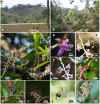Different pollinator assemblages ensure reproductive success of Cleisostoma linearilobatum (Orchidaceae) in fragmented holy hill forest and traditional tea garden
- PMID: 26907369
- PMCID: PMC4764900
- DOI: 10.1038/srep21435
Different pollinator assemblages ensure reproductive success of Cleisostoma linearilobatum (Orchidaceae) in fragmented holy hill forest and traditional tea garden
Abstract
Orchids are generally recognized to have specialist pollination systems and low fruit set is often thought to be characteristic of the family. In this study, we investigated the reproductive ecology of Cleisostoma linearilobatum, an epiphytic tropical orchid, in a holy hill forest fragment and a traditional tea garden in SW China using comparable methods. C. linearilobatum is self-compatible and dependent on insects for pollination. Fruit production in natural conditions was both pollinator- and resource-limited. However, the natural fruit set remained stable over multiple years at both sites. Pollination observations showed that C. linearilobatum has a generalized pollination system and seven insect species were observed as legitimate pollinators. Although the visit frequencies of different pollinators were different in the two sites, the pollinator assemblages ensured reproductive success of C. linearilobatum in both study sites over multiple years. The results partly explain why C. linearilobatum is so successful in the area, and also suggest that holy hill forest fragments and traditional tea gardens in Xishuangbanna are important in preserving orchids, especially those with generalist pollination.
Figures



Similar articles
-
Orchid pollination by sexual deception: pollinator perspectives.Biol Rev Camb Philos Soc. 2011 Feb;86(1):33-75. doi: 10.1111/j.1469-185X.2010.00134.x. Biol Rev Camb Philos Soc. 2011. PMID: 20377574 Review.
-
Floral isolation, specialized pollination, and pollinator behavior in orchids.Annu Rev Entomol. 2009;54:425-46. doi: 10.1146/annurev.ento.54.110807.090603. Annu Rev Entomol. 2009. PMID: 19067636 Review.
-
Mechanisms and evolution of deceptive pollination in orchids.Biol Rev Camb Philos Soc. 2006 May;81(2):219-35. doi: 10.1017/S1464793105006986. Biol Rev Camb Philos Soc. 2006. PMID: 16677433 Review.
-
Breeding system and factors limiting fruit production in the nectarless orchid Broughtonia lindenii.Plant Biol (Stuttg). 2011 Jan;13 Suppl 1:51-61. doi: 10.1111/j.1438-8677.2010.00366.x. Plant Biol (Stuttg). 2011. PMID: 21134087
-
Pollination ecology of two species of Elleanthus (Orchidaceae): novel mechanisms and underlying adaptations to hummingbird pollination.Plant Biol (Stuttg). 2016 Jan;18(1):15-25. doi: 10.1111/plb.12312. Epub 2015 Mar 26. Plant Biol (Stuttg). 2016. PMID: 25678071
Cited by
-
Pollination in the Rainforest: Scarce Visitors and Low Effective Pollinators Limit the Fruiting Success of Tropical Orchids.Insects. 2021 Sep 23;12(10):856. doi: 10.3390/insects12100856. Insects. 2021. PMID: 34680625 Free PMC article.
-
A comparative study on the reproductive success of two rewarding Habenaria species (Orchidaceae) occurring in roadside verge habitats.BMC Plant Biol. 2021 Apr 19;21(1):187. doi: 10.1186/s12870-021-02968-w. BMC Plant Biol. 2021. PMID: 33874891 Free PMC article.
-
Floral mechanisms promote pollination success and reduce the incidence of self-pollination in a fly-pollinated self-incompatible orchid.Ecol Evol. 2024 Apr 24;14(4):e11295. doi: 10.1002/ece3.11295. eCollection 2024 Apr. Ecol Evol. 2024. PMID: 38660471 Free PMC article.
-
Pollen transfer and patterns of reproductive success in pure and mixed populations of nectariferous Platanthera bifolia and P. chlorantha (Orchidaceae).PeerJ. 2022 Jun 13;10:e13362. doi: 10.7717/peerj.13362. eCollection 2022. PeerJ. 2022. PMID: 35722265 Free PMC article.
References
-
- McCormick M. K. & Jacquemyn H. What constrains the distribution of orchid populations? New Phytol. 202, 392- 400 (2014).
-
- Waterman R. J. et al. The effects of above- and belowground mutualisms on orchid speciation and coexistence. Am. Nat. 177, E54–E68 (2011). - PubMed
-
- Ackerman J. D. & Montalvo A. M. Short- and long-term limitations to fruit production in a tropical orchid. Ecology 71, 263–272 (1990).
-
- Tremblay R. L., Ackerman J. D., Zimmerman. J. K. & Calvo R. N. Variation in sexual reproduction in orchids and its evolutionary consequences: a spasmodic journey to diversification. Biol. J. Linn .Soc. 84, 1–54 (2005).
Publication types
MeSH terms
LinkOut - more resources
Full Text Sources
Other Literature Sources

